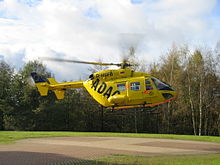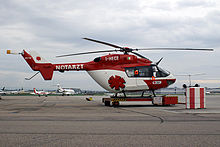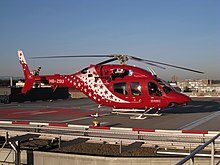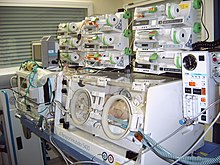Intensive care transport helicopter
The intensive care transport helicopter ( ITH ) is an air rescue device whose main application is the transfer of intensive care patients by air. These transfers require that the patient is already under clinical care in an intensive care unit and that, from a medical point of view, rapid transport to a special clinic is urgently required. This distinguishes it from the rescue helicopter (RTH), which for so-called primary missions so that emergency rescue is used. Relocations are therefore generally referred to as secondary use in the rescue service .
Patients of the intensive care transport helicopter are transferred between intensive care units, so they are always subject to intensive care. The ground-based counterpart of the ITH is the intensive care transport vehicle (ITW).
history
The first intensive care transport helicopter in Germany was put into service in 1991 in Munich by the Arbeiter-Samariter-Bund (ASB). The machine was initially coordinated by the ASB's own control center; central coordination only began later via a joint control center for intensive-care transport helicopters.
In fact, on November 20, 1990, the first permanently stationed intensive care transport helicopter with the radio call name “Bayern Sama Süd” was put into service as a pilot project with a Bell 222 in Munich. The "flying intensive care unit" was officially presented to the public on December 19, 1990 at a press conference at Klinikum-Großhadern as a joint project between Aero-Dienst Nürnberg, Arbeiter-Samariter-Bund Munich and the Institute for Anesthesiologists and the Surgical Clinic of Klinikum-Großhadern .
In Austria , the first intensive care transport helicopter was put into service by the ÖAMTC as a pilot project in July 1999 , and since then it has flown an average of 537 missions per year as the only ITH in Austria.
Before dedicated intensive care transport helicopters were used, intensive care relocations were flown by rescue helicopters and so-called "ambulance helicopters" - just as in ground-based intensive care transport corresponding operations were taken over by ambulances accompanied by a doctor or an ambulance prior to the implementation of intensive care transport vehicles . You had to accept that the ventilation options and the space available were limited. Ambulance helicopters with a deployment area that was comparable to that of the later ITH were implemented in the air rescue network as early as the mid-1980s, for example by the DRF Luftrettung in Hartenholm (later Christoph 52 in Itzehoe and now Christoph Europa 5 in Niebüll). These helicopters were often not part of public air rescue for many years. Even today, individual locations are controversial in this regard: ITH in Harste (no longer existent), ITH in Dortmund, ITH in Rostock, ITH in Bielefeld (no longer existent).
Advantage of specialization
Because intensive-care transport helicopters are available in addition to rescue helicopters, the often very protracted and time-consuming intensive-care transfers can be carried out more easily: the rescue helicopter, which is required for primary operations, i.e. for emergency rescue, is not blocked by such transfers.
In addition, some of the intensive care devices that an intensive care transport helicopter has at their disposal are rarely used in normal rescue services. Keeping these devices available on all rescue helicopters would mean an enormous cost burden.
Helicopter types

Because of the high payload and the larger space requirement, larger helicopter models are used for the intensive care transport helicopter than for rescue helicopters. E.g .: Eurocopter BK117 / EC145 and Dauphin , Bell 412 . Earlier types Bell 222, Agusta A109 and MD 902 no longer fly in Germany as ITH.
They have the required higher payload and range . The DRF Luftrettung calls z. B. for the Bell 412 a range of 700 km with a maximum take-off weight of 5.4 tons. In addition, up to 1,250 liters of fuel can be filled.
equipment
The minimum equipment of intensive care transport helicopters is regulated by DIN 13230-10. (Almost) all intensive care procedures and monitoring options are available during the flight.
Device for patient transport
Often, specially designed stretchers are used on the helicopter that have additional brackets for the monitor , ventilator and syringe pumps .
Ventilator
Compared to a rescue helicopter, the significantly more complex ventilation machines should be mentioned. With the intensive care ventilators, differentiated ventilation patterns can be used that simpler emergency ventilators cannot offer.
Capnometry , which determines the expiratory carbon dioxide content , can be used to monitor ventilation .
The compressed air required for ventilation is generated on the intensive care transport helicopter as well as on modern intensive care transport vehicles with on-board compressors (so-called air pumps) and temporarily stored in a compressed air tank or carried with compressed air cylinders.
The ventilators can be operated on board via a 230-volt network, and for use outside the helicopter they have a powerful battery.
Monitoring
In contrast to most rescue helicopters, there is the option of invasive blood pressure measurement (IBP), in which the blood pressure is determined via an arterial cannula. It is also possible to measure the central venous pressure .
In addition, the intensive care transport helicopter has extended monitoring options:
- If necessary, intensive incubators can also be included for the transfer of newborns requiring intensive care .
- Blood sugar measurement technology
- Syringe pumps for injections and infusions
- external pacemaker , EKG , defibrillator
- Device to immobilize extremities and (cervical) spine
- various drugs of different types
- Device for disinfection
- Further additional and special equipment.
Calls
The intensive care transport helicopters are primarily used in the field of interclinical transports (multiple trauma patients , burn victims , incubator transports ), less often for organ transports or the relocation of surgical teams. They are often used for moving from hospitals with a lower level of care to hospitals with the highest level of care and for moving patients who require special treatment methods or devices that are only available in a few hospitals.
The intensive care transport helicopters are coordinated by their own control centers . In Bavaria z. B. a central control center, the coordination center for intensive care transport helicopters (KITH; affiliated to the integrated control center Munich ), is responsible for all of Bavaria. The rescue helicopters are coordinated by the respective local rescue control centers.
If necessary, the intensive care transport helicopter can also be involved in primary rescue as a rescue helicopter. This option is particularly popular at night , as the intensive care transport helicopters are manned at night, unlike most rescue helicopters.
costs
The costs for the use of the intensive care transport helicopter, as well as for the use of the rescue helicopter, are largely covered by the health insurance companies (approx. 76%). The cost units are usually billed according to flight minutes. The price per flight minute is u. a. determined from the costs of the previous year.
For those insured in the statutory health insurance , the health insurance companies take over according to § 60 SGB V u. a. the costs of a transfer that is necessary for compelling medical reasons. The amount of the co-payment is a maximum of 10 euros ( Section 61 sentence 1 SGB V). Privately insured persons receive an invoice for the helicopter operation, which can be presented to the private health insurance company (and, if applicable, within the scope of the allowance ) for (pro rata) reimbursement.
A BK 117, the smallest machine used in intensive care transport, costs around 3.4 million euros to purchase (2005). The costs for medical equipment as well as the maintenance and operating costs must be added.
The costs for using the intensive care transport helicopter are higher than those for a rescue helicopter, which in turn are significantly higher than those for an intensive care transport vehicle. The ordering doctor must therefore weigh the advantages and disadvantages from a medical point of view. Transport by helicopter is generally preferable, especially for longer distances, as it is gentler on the patient.
In Lower Saxony, the additional payment costs in 2004/2005 averaged around EUR 450 per deployment over 18 months. The actual costs in 2005 amounted to 3400-4800 euros (including all mandatory maintenance, repairs, depreciation of the helicopter, instruments, etc.), of which the health insurances took over the majority in the settlement with the air rescue providers / operators. Financial resources of the private air rescue organizations and the executing agencies compensate for deficits.
crew
The flight crew consists of at least one pilot who is supported by an on-board technician or a second pilot depending on the area of operation, the type of helicopter or the time of day or night. If the deployment takes place under instrument flight conditions, e.g. B. at night, a flight crew consisting of two pilots is required.
The patient is looked after by an emergency doctor with intensive medical experience and a paramedic (Germany) or an emergency paramedic (Austria) with additional training as a HEMS crew member ; often associated with intensive medical training or specialist nursing training in the field of anesthesia / intensive care medicine.
When transporting premature babies or newborns, the transport is usually accompanied by a perinatal team; consisting of a neonatologist or pediatrician and a pediatric nurse with intensive medical training.
operator
The intensive care transport helicopters are operated, for example, by the DRF Luftrettung , the Johanniter-Unfall-Hilfe and the ADAC Luftrettung as well as the Christophorus Flugrettungsverein ÖAMTC . The non-medical medical staff is usually provided by aid organizations / fire brigades, the doctors are usually provided by the on-site clinics.
Support points (selection)
16 intensive care transport helicopters are used throughout Germany.
| Nickname | city | country | operator | Internet | comment |
|---|---|---|---|---|---|
| Air Rescue Nürburgring |
Nürburgring (officially Adenau ) |
|
Johanniter-Unfall-Hilfe / Heli-Flight |
data sheet | Officially Akkon Koblenz 17 / 89-01, on the radio as Air Rescue Nürburgring (until May 1, 2016 Christoph Nürburgring) |
| ( Air Rescue Pfalz a. D.) | Sembach |
|
Johanniter-Unfall-Hilfe / Heli-Flight |
data sheet | Stationed in Sembach from October 22, 2018 to September 2, 2019. Mainly used to transport patients between the locations of the West Palatinate Clinic . Was replaced by the Christoph 66 at the beginning of September 2019 . |
| Akkon Bochum 89-1 | Bochum |
|
Johanniter-Unfall-Hilfe / Heli-Flight |
data sheet | Stationed at the Loemühle airfield in the district of Marl (Recklinghausen district / NRW); the intensive care physician comes from the professional association University Hospital Bergmannsheil; an air rescue center is not planned at Bergmannsheil |
| Christoph Berlin | Berlin |
|
DRF air rescue | data sheet | call sign on air radio "Christoph 82", BOS nickname "Christoph Berlin" / ID of Florian Berlin "ITH 6106", 24h operational, dual-use for primary and secondary missions, stationed at the accident hospital Berlin, pilots and HEMS-TC of the DRF , Provision of emergency doctors by the Unfallkrankenhaus Berlin, DRK Klinikum Westend, Vivantes Klinikum im Friedrichshain and Vivantes Klinikum Neukölln |
| Christoph Brandenburg | Senftenberg |
|
ADAC air rescue | data sheet | shared location with Christoph 33, ready for use around the clock |
| Christoph Dortmund | Dortmund - Wickede |
|
DRF air rescue | data sheet | formerly Florian 0-84-1
not under public law |
| Christoph Hansa | Hamburg |
|
ADAC air rescue | data sheet | 85% primary operations, former ADAC internal account number Christoph 50 |
| Christoph Munich | Munich - Großhadern |
|
DRF air rescue | data sheet | formerly ITH Munich , ready for use around the clock. Name was originally Sama Munich 78-1 |
| Christoph Lower Saxony | Hanover |
|
DRF air rescue | data sheet | ready for use around the clock; Call-sig: Christoph 86 on the radio |
| Christoph Nuremberg | Nuremberg |
|
DRF air rescue | data sheet | shared location with Christoph 27, ready for use around the clock |
| Christoph Mittelhessen | Reichelsheim |
|
Johanniter-Unfall-Hilfe / Heli-Flight |
data sheet | primarily ITH, but also primary assignments; in connection with Christoph Gießen |
| Christoph Rhineland | Cologne |
|
ADAC air rescue | data sheet | formerly Christoph 75 (ADAC internal account number). The location is Cologne / Bonn Airport |
| Christoph Rostock | Rostock |
|
Johanniter accident aid / rotor flight |
data sheet | ready for use around the clock |
| Christoph Saxony-Anhalt | Halle (Saale) |
|
DRF air rescue | data sheet | ready for use around the clock |
| Christoph Thuringia |
Bad Berka (near Erfurt ) |
|
DRF air rescue | data sheet | ready for use around the clock |
| Christoph Weser | Bremen |
|
DRF air rescue | data sheet | not under public law, previously different BOS radio call names |
| Christoph Westphalia | Greven |
|
ADAC air rescue | data sheet | Ready for use around the clock, ADAC accounting internal designation Christoph 76 |
Dual use (primary and secondary use)
Twelve dual-use helicopters are used across Germany
| Nickname | city | country | operator | Internet | comment |
|---|---|---|---|---|---|
| Christoph 42 | Rendsburg |
|
DRF air rescue | data sheet | ready for use around the clock |
| Christopher 51 | Stuttgart |
|
DRF air rescue | data sheet | |
| Christoph Europe 5 | Niebüll |
|
DRF air rescue | data sheet | formerly Christoph 52 in Itzehoe , before that in Hartenholm for over 20 years and also on night flights, also flies cross-border missions to Denmark |
| Christoph 53 | Mannheim |
|
DRF air rescue |
Datasheet Internet presence of Christoph 53 |
formerly Flugwacht Mannheim 71 |
| Christopher 54 | Freiburg in Breisgau |
|
DRF air rescue | data sheet | formerly Flugwacht Freiburg 71 |
| Christoph 62 | Bautzen |
|
DRF air rescue |
Datasheet information about Christoph 62 |
ready for use around the clock, with mountain rope |
| Christoph 66 | Eßweiler |
|
ADAC air rescue | data sheet | Since September 2, 2019 in test operation, whether there will be a permanent helicopter in the West Palatinate. Replaces the Air Rescue Palatinate of Johanniter-Unfall-Hilfe e. V. / Heli-Flight. The area of application of the machine includes primary missions, i.e. classic rescue missions, city and district of Kaiserslautern as well as the districts of Kusel and Birkenfeld and the Donnersberg district. The area for secondary missions, such as transfer flights, therefore extends to Rhineland-Palatinate and Saarland. The machine is used from sunrise to sunset, and night flights are also technically possible. |
| Christoph Murnau | Murnau |
|
ADAC air rescue | data sheet | Former ADAC internal account number Christoph 74, ITH, approx. 60% primary use, equipped with winch |
| Christopher 77 | Mainz |
|
ADAC air rescue |
Datasheet Internet presence of Christoph 77 |
|
| Christoph Halle | Halle (Saale) |
|
DRF air rescue | data sheet | unofficial Christoph 85 , second replacement for Christoph Sachsen-Anhalt (only during the day) |
| Christoph Giessen | to water |
|
Johanniter-Unfall-Hilfe / Heli-Flight |
data sheet | unofficial Christoph 90, until 2006 Christoph Reichelsheim, until February 28, 2014 Christoph Hessen, ready for action around the clock, primarily ITH, but also primary assignments, in connection with Christoph Mittelhessen |
| Christoph Regensburg | regensburg |
|
DRF air rescue | data sheet | ready for use around the clock |
literature
- J. Hinkelbein, E. Glaser (Ed.): Aviation medicine . UniMed-Verlag, Bremen 2007
- M. Weinlich, M. Mühlmeyer, A. Reichert, R. Jaki: Intensive care transport in the air . Experience in Baden-Württemberg in Emergency & Rescue Medicine Vol. 4 No. 2 March 2001, pp. 93-101, Springer-Verlag, Heidelberg, ISSN 1434-6222
- H. Scholl: Air rescue . S & K-Verlag, 1st edition 2002, ISBN 3-932750-77-2 .
- Thierbach, Veith: Practical Guide to Interhospital Transfer . S & K-Verlag, ISBN 3-932750-95-0 .
Individual evidence
- ↑ Roland Huf: The flying intensive care unit. In: "Air rescue - chance for survival". Congress report on AIRMED 1996 from 11. – 14. June 1996 in Munich. "Air rescue - chance for survival" / ADAC World Congress Aeromedical Service . Ed .: ADAC-Luftrettung GmbH Munich, Gerhard Kugler . W. Wolfsfellner, Munich 1997, ISBN 3-9802271-2-X , p. 201-206 .
- ↑ https://www.rth.info/stations.db/stations.php - accessed on October 7, 2018.
- ↑ Sembach: Rescue helicopter stationed (with photo gallery). In: rheinpfalz.de. Retrieved October 22, 2018 .
- ^ Jörn Fries: Reallocation in Saxony: Change of operator at RTH stations in Bautzen and Zwickau (added). In: rth.info. August 17, 2018, accessed September 16, 2018 .
- ^ "Christoph 66" stationed in Eßweiler. In: SWR.de. Retrieved September 2, 2019 .






